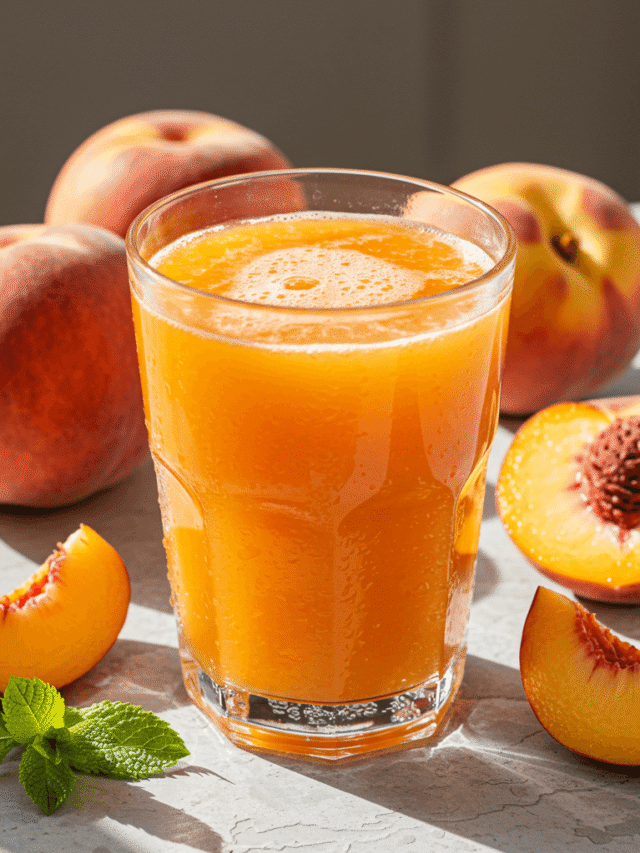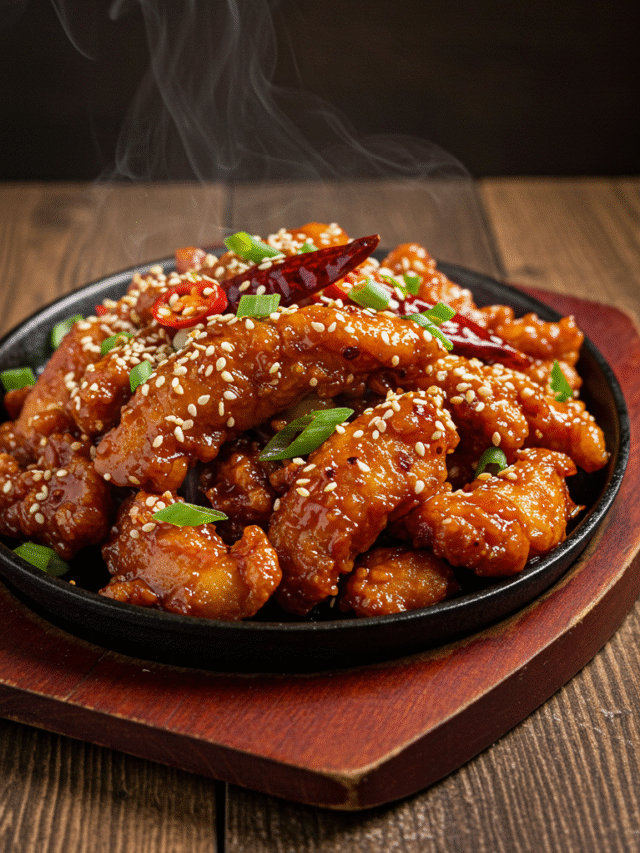Introduction to Pineapple Pound Cake
The rich buttery taste of a classic pound cake combined with sweet tropical pineapple creates a dessert that brings joy to any occasion. Pineapple pound cake stands as a beloved favorite among home bakers and dessert enthusiasts alike. This golden, moist treat balances the dense, velvety texture of traditional pound cake with the bright, tangy notes of pineapple. Whether you’re baking for a family gathering, special celebration, or simply craving something sweet, this cake delivers both comfort and a touch of tropical flair.
Pound cake gets its name from the original recipe that used a pound each of four key ingredients: flour, butter, eggs, and sugar. America’s Test Kitchen explains that this equal-weight formula creates the cake’s signature dense crumb and rich texture. The science behind pound cake involves careful balance between fat and moisture, which gives these cakes their remarkable shelf life and satisfying mouthfeel.
The addition of pineapple to pound cake happened as bakers began to experiment with fruit additions. Pineapple contains natural enzymes that help tenderize baked goods, resulting in an exceptionally moist cake. The fruit’s natural sweetness and slight acidity create depth of flavor while complementing the buttery richness of the cake base. Many bakers consider pineapple cake recipes among their most requested desserts because they offer universal appeal.
What Makes a Perfect Pineapple Pound Cake
The perfect pineapple pound cake combines several key qualities:
- Balanced texture – neither too dense nor too light
- Even moisture throughout the cake
- Golden crust with a tender interior
- Visible pineapple pieces that don’t sink to the bottom
- Buttery aroma with hints of tropical sweetness
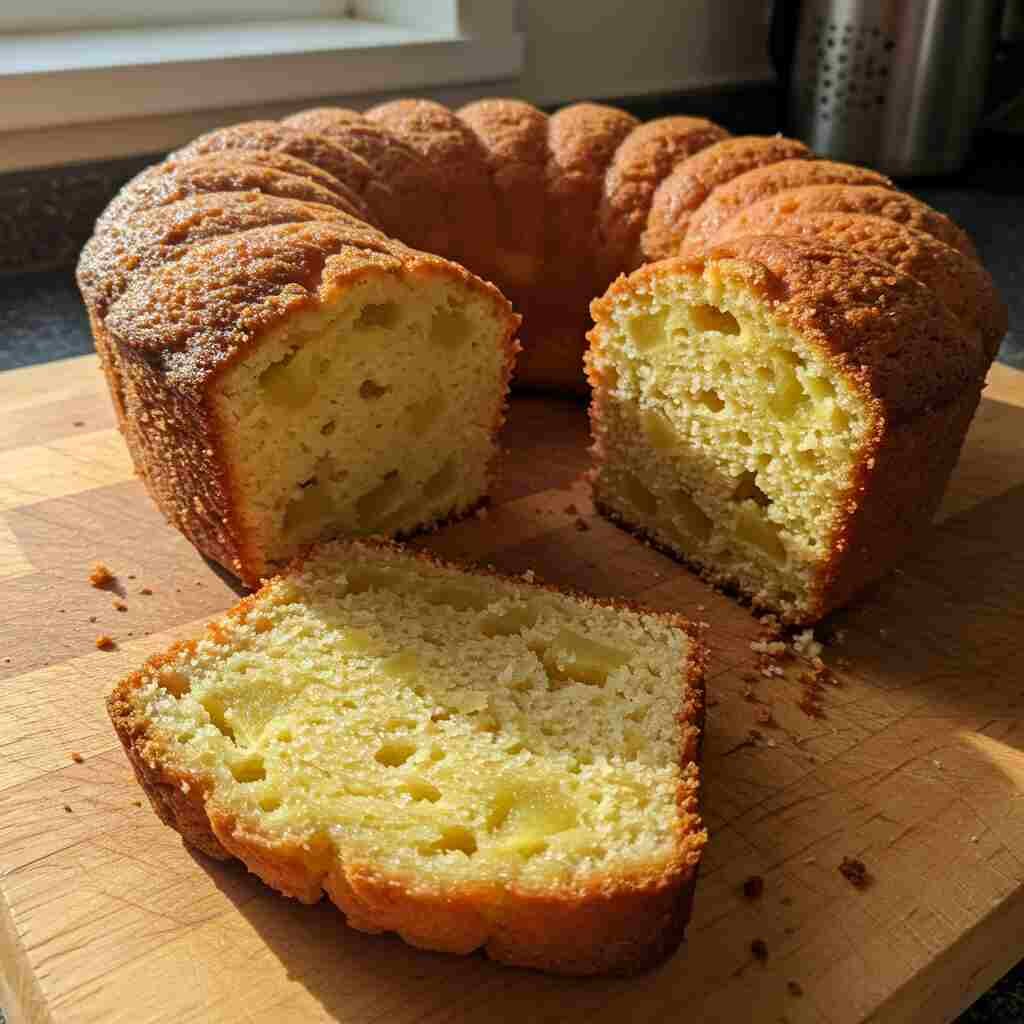
Key Characteristics of a Great Pound Cake
Pound cake differs from regular cake primarily in its structure. While regular cakes often use leavening agents for a fluffy texture, pound cake relies more on the air incorporated during the creaming process. This creates the characteristic fine crumb and denseness that pound cake lovers crave. The best pound cake recipes follow careful mixing techniques:
- Beat butter until very light and fluffy before adding sugar
- Add eggs one at a time, fully incorporating each
- Mix dry ingredients just until combined to avoid tough texture
- Use room temperature ingredients for best volume
The process of making pound cake requires patience. Properly creaming butter and sugar can take up to 5 minutes with a stand mixer. This step creates tiny air pockets that expand during baking, giving the cake its rise without relying heavily on chemical leaveners.
Check out our guide to butter creaming techniques for more detailed instructions.
The Pineapple Difference
Adding pineapple transforms a traditional pound cake into something special. You can use pineapple in several forms:
- Crushed pineapple for even distribution
- Pineapple chunks for more pronounced fruit presence
- Pineapple juice in the batter or glaze
- Dried pineapple as a mix-in or garnish
When adding crushed pineapple to cake, the moisture content becomes crucial. Too much liquid can make the cake soggy, while too little won’t impart enough flavor. Most successful recipes drain canned pineapple partially, reserving the juice for glaze or to brush on the finished cake.
The natural acids in pineapple react with dairy products and leavening agents, creating a tenderizing effect on the cake structure. This chemical reaction helps produce a cake that stays moist for days after baking. The enzymes in fresh pineapple, particularly bromelain, break down proteins, which affects how the cake sets up.
For more information about working with tropical fruits in baking, see our complete guide to fruit-based cakes.
Pineapple also brings natural sweetness, reducing the need for added sugar in many recipes. The caramelization of the fruit’s natural sugars during baking adds depth to the flavor profile and contributes to the golden color of the finished cake.
The right balance of pineapple creates a moist pineapple dessert that maintains the integrity of pound cake while offering something uniquely delicious. Many bakers consider the pineapple pound cake recipe a perfect gateway to more advanced fruit-based baking projects.
Learn more about selecting the right type of pineapple for your baking needs in our tropical fruit selection guide.
Essential Ingredients Breakdown
Creating the perfect pineapple pound cake starts with understanding each ingredient’s role. Quality ingredients make all the difference between an ordinary cake and an extraordinary one. Let’s break down what you need and why each component matters.
Traditional Pound Cake Ingredients
Butter
High-quality butter forms the foundation of any great pound cake:
- Use unsalted butter for better control of flavor
- Butter should be at room temperature (65-67°F)
- European-style butter with higher fat content creates richer results
- The fat in butter traps air during creaming, creating structure
The temperature of your butter greatly affects your cake’s final texture. Too cold, and it won’t cream properly. Too warm, and it won’t hold air bubbles. You want butter soft enough that your finger leaves an indent with gentle pressure.
Sugar
Sugar does more than just sweeten your cake:
- Granulated sugar cuts into butter during creaming, creating air pockets
- Sugar stabilizes egg proteins, improving structure
- It attracts moisture, helping keep your cake fresh longer
- White sugar creates a lighter cake, while brown sugar adds moisture and caramel notes
Many bakers experiment with sugar types in their pound cake recipes. A combination of granulated and light brown sugar adds depth while maintaining the classic pound cake texture.
Flour
Choosing the right flour affects your cake’s structure:
- All-purpose flour works for most recipes
- Cake flour creates a more tender crumb
- Measure by weight rather than volume for accuracy
- Sift flour for even distribution and fewer lumps
The protein content in flour forms gluten when mixed with liquid. For pound cakes, you want minimal gluten development to avoid toughness. This means mixing just until ingredients combine, rather than beating extensively after adding flour.
For specialty flour options, check out this guide from the Smithsonian Magazine which discusses historical baking ingredients and their modern equivalents.
Eggs
Eggs provide structure, richness, and color:
- Use large eggs at room temperature
- Add eggs one at a time, beating well between each
- Eggs create emulsion with butter, trapping air
- Yolks add fat and richness, whites add structure
The number of eggs in pound cake recipes varies. Traditional recipes use 4-6 eggs for a standard loaf. More eggs create a richer, more custard-like texture.
Pineapple Options
When adding pineapple to cake, you have several choices:
- Fresh pineapple: Brightest flavor but contains enzymes that can affect texture
- Canned pineapple: Consistent results and convenient
- Crushed pineapple: Even distribution throughout the cake
- Pineapple chunks: More noticeable fruit pieces in each bite
- Pineapple juice: Adds flavor to the batter without changing texture too much
Most home bakers prefer canned crushed pineapple for consistent results. The canning process deactivates the enzymes that might otherwise prevent your cake from setting properly.
When using canned pineapple, drain it first and save the juice. This helps control moisture content in your cake and gives you juice for glaze or soaking syrup.
Visit our tropical fruit baking tips to learn more about working with various fruit preparations.
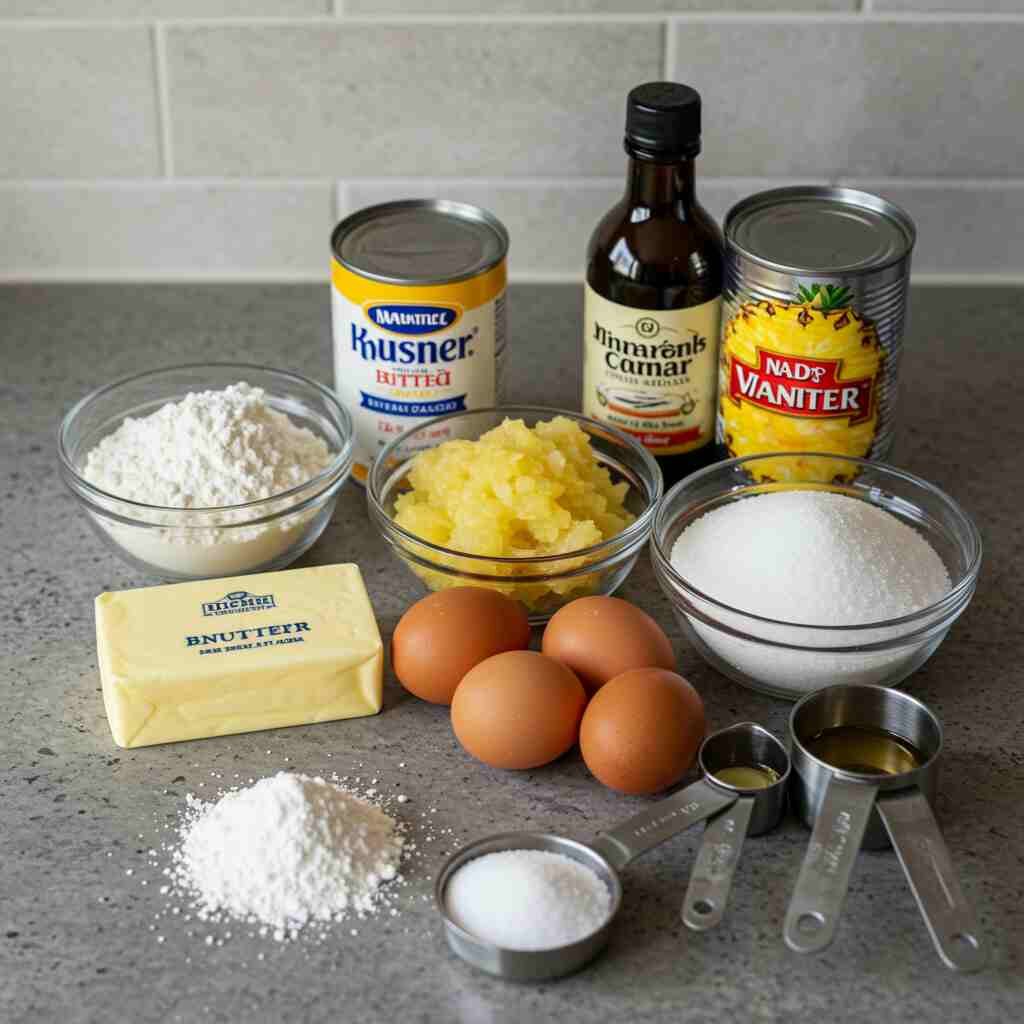
Complementary Flavors
Pineapple pairs beautifully with other flavors to create more complex taste profiles:
- Vanilla: Adds depth and warmth to the tropical pineapple notes
- Coconut: Creates a tropical theme in your cake
- Rum: Brings out the natural sweetness of pineapple
- Cinnamon: Adds subtle warmth that balances fruit acidity
- Brown sugar: Creates caramel notes that complement pineapple
Many pineapple cake recipes include coconut in the form of flaked coconut, coconut milk, or coconut extract. This combination creates a cake reminiscent of tropical vacation treats.
For extracts, use pure rather than imitation when possible. The flavor difference comes through clearly in the finished cake. A teaspoon of good vanilla extract improves almost any pound cake recipe.
You can also try less common pairings like ginger or lime zest. These bright flavors cut through the richness of the pound cake and highlight the pineapple’s natural acidity.
For more unique flavor combinations, see our complete guide to flavor pairing which explores complementary taste profiles.
Light rum or dark rum both work well in pineapple pound cake. Light rum adds subtle sweetness without overwhelming the pineapple flavor. Dark rum brings deeper molasses notes that create a more complex taste. Just 2-3 tablespoons adds flavor without making the cake taste alcoholic.
Step-by-Step Pineapple Pound Cake Recipe
Now that we understand the ingredients, let’s walk through making a perfect pineapple pound cake from start to finish. This detailed guide breaks down each stage of the process so you can achieve amazing results every time with your homemade pineapple pound cake.
Equipment Needed
Before you start mixing your pineapple pound cake batter, gather these essential tools:
- Loaf pan or bundt pan (9×5 inch loaf or 10–12 cup bundt)
- Stand mixer or hand mixer with large bowl
- Measuring cups and spoons (or kitchen scale for best accuracy)
- Rubber spatula for scraping down bowl sides
- Mixing bowls for dry and wet ingredients
- Sifter or fine-mesh strainer for flour
- Cooling rack for proper cake cooling
- Toothpick or cake tester to check doneness
The right pan makes a big difference in how your pineapple pound cake bakes. Light-colored metal pans heat more evenly than dark ones. If you use a dark pan, lower your oven temperature by 25°F to prevent over-browning.
Non-stick pans work well for pineapple pound cakes, but still grease and flour them for easy removal. For bundt pans with detailed designs, use a baking spray that contains flour for complete coverage of all the nooks and crannies.
Preparation Process
Step 1: Prepare Your Ingredients
- Set butter and eggs out 1 hour before baking to reach room temperature
- Preheat your oven to 325°F (165°C)
- Grease and flour your baking pan thoroughly
- Drain canned crushed pineapple, saving juice for later use
- Measure all ingredients before starting
Room temperature ingredients blend better and trap more air. This creates a lighter pineapple pound cake despite its rich ingredients. Cold eggs can cause your butter mixture to curdle or separate.
Step 2: Mix Dry Ingredients
Sift or whisk together:
- 3 cups all-purpose flour
- 1/2 teaspoon baking powder
- 1/2 teaspoon salt
Mixing dry ingredients separately helps them distribute evenly throughout the batter. This prevents flour pockets in your finished pineapple pound cake and helps create consistent texture.
Step 3: Cream Butter and Sugar
- Beat 1 cup (2 sticks) butter until light and fluffy, about 2–3 minutes
- Gradually add 2 cups sugar while beating
- Continue beating for 4–5 minutes until very pale and fluffy
- Scrape down bowl sides frequently
This creaming step creates tiny air bubbles that expand during baking. The longer you cream, the lighter your pineapple pound cake will be. The mixture should almost double in volume and look almost white.
Step 4: Add Eggs
- Add 4 eggs one at a time
- Beat well after each addition, about 30 seconds per egg
- Scrape down bowl sides after each egg
- Mix in 2 teaspoons vanilla extract
Adding eggs gradually keeps the emulsion stable. If you add them too quickly, your batter might separate. Each egg should fully disappear into the batter before adding the next one, ensuring your pineapple pound cake has a smooth, consistent texture.
Step 5: Alternate Dry Ingredients and Pineapple
- Add 1/3 of the flour mixture, mix just until combined
- Add half the drained pineapple (1 cup), mix briefly
- Add another 1/3 of flour, mix just until combined
- Add remaining pineapple, mix briefly
- Add final 1/3 of flour, mix just until combined
This alternating method helps maintain a smooth batter. Finish mixing with a rubber spatula by hand to avoid overmixing. The final batter should look thick but pourable with visible pineapple pieces, perfect for your pineapple pound cake.
Step 6: Transfer to Pan
- Pour or spoon batter into prepared pan
- Smooth the top with a spatula
- Tap pan gently on counter to remove air bubbles
Fill your pan about 2/3 full. This gives the pineapple pound cake room to rise without overflowing. For even more pineapple flavor, sprinkle a few extra pieces on top before baking.

Baking Guidelines
Temperature and Timing
- Bake at 325°F (165°C) for 60–75 minutes for a loaf pan
- Bake at 325°F (165°C) for 50–60 minutes for a bundt pan
- Place pan in the center of the oven for even heat
- Don’t open the oven door during the first 45 minutes
Lower and slower baking creates the perfect pineapple pound cake texture. Higher temperatures might brown the outside before the inside cooks completely. The gentle heat helps develop the cake’s signature dense, moist crumb.
Testing for Doneness
A properly baked pineapple pound cake will show these signs:
- Toothpick inserted in center comes out clean or with a few moist crumbs
- Cake pulls away slightly from pan sides
- Top springs back when lightly touched
- Internal temperature reaches about 210°F if using a thermometer
- Surface looks golden brown with possible slight crack on top
If the toothpick shows wet batter, continue baking in 5-minute increments, checking after each. If the top browns too quickly but the center remains uncooked, tent loosely with foil to protect your pineapple pound cake.
Cooling Process
- Cool in pan on wire rack for 15 minutes
- Remove from pan and cool completely on rack
- Wait at least 2 hours before slicing for best texture
Proper cooling helps your pineapple pound cake set and develop flavor. Cutting too soon makes the texture gummy and causes the cake to collapse. The cooling process actually completes the cooking as residual heat continues working through the cake.
For extra moisture and flavor, brush the warm pineapple pound cake with 1/4 cup reserved pineapple juice mixed with 2 tablespoons sugar. This creates a light, sweet glaze that soaks into the cake as it cools.
Variations and Creative Twists for Pineapple Pound Cake
The classic pineapple pound cake offers a wonderful starting point for creative baking adventures. With a few changes to the basic recipe, you can create exciting variations that match any occasion or taste preference. Let’s explore some popular twists on this tropical favorite.
Pineapple Upside-Down Pound Cake
This stunning variation combines two beloved classics: pineapple pound cake and pineapple upside-down cake. The result gives you the dense, rich texture of pineapple pound cake with the caramelized fruit top of an upside-down cake.
To make this show-stopping pineapple pound cake dessert:
- Start with a 10-inch round cake pan or 9×13 baking dish
- Melt 1/4 cup butter in the pan
- Sprinkle 2/3 cup brown sugar evenly over butter
- Arrange pineapple rings or chunks in a single layer
- Place maraschino cherries in pineapple ring centers (optional)
- Pour prepared pineapple pound cake batter over fruit layer
- Bake as directed, adding 5–10 minutes to account for the fruit layer
The magic happens when you flip this pineapple pound cake after cooling for just 10 minutes. The butter and brown sugar create a caramel sauce that soaks into the fruit and cake top. This creates a moist, sweet layer that contrasts beautifully with the pineapple pound cake beneath.
For best results, run a knife around the edge of the pan before flipping. Place your serving plate on top of the pan, then quickly but confidently turn everything over. Wait about 30 seconds before lifting the pan to allow the caramel to release naturally.
Glazes and Frostings for Pineapple Pound Cake
A simple glaze or light frosting adds flavor and visual appeal to your pineapple pound cake recipes. Here are three options that work beautifully:
Pineapple Glaze
- Mix 1 cup powdered sugar with 2–3 tablespoons pineapple juice
- Stir until smooth with no lumps
- Add more juice for thinner glaze or more sugar for thicker consistency
- Pour over cooled pineapple pound cake and let set for 30 minutes
This simple glaze adds a sweet-tart punch that boosts the pineapple flavor in your pineapple pound cake. The clear glaze shows off any fruit pieces in your cake while adding a pretty shine.
Cream Cheese Frosting
- Beat 8 oz softened cream cheese until fluffy
- Add 1/4 cup softened butter and beat until combined
- Mix in 2 cups powdered sugar gradually
- Stir in 1 teaspoon vanilla extract
- Spread over cooled pineapple pound cake with offset spatula
The tangy cream cheese balances the sweetness of the pineapple pound cake. This richer topping makes your cake feel more like a special occasion dessert. For a tropical twist, add 1/2 teaspoon coconut extract to the frosting.
Rum Glaze
- Combine 1 cup powdered sugar with 1 tablespoon rum
- Add 1–2 tablespoons pineapple juice until pourable
- Whisk until completely smooth
- Drizzle over pineapple pound cake while still slightly warm
This grown-up glaze adds sophisticated flavor that complements the pineapple pound cake perfectly. The alcohol cooks off, leaving just the rum flavor behind. For an alcohol-free version, use rum extract instead (start with 1/2 teaspoon and adjust to taste).
Add-ins and Flavor Enhancers for Pineapple Pound Cake
Take your pineapple pound cake to the next level with these tasty additions:
Nuts and Texture Elements
- Chopped macadamia nuts – Add 1/2 cup to batter for tropical crunch
- Toasted coconut – Sprinkle 1/3 cup into batter or use as topping
- White chocolate chips – Fold in 1/2 cup for sweet creamy bites
- Dried pineapple pieces – Add chewy texture contrast
When adding nuts to your pineapple pound cake, toss them in 1 tablespoon of flour first. This helps prevent sinking to the bottom during baking. For the best flavor, toast nuts in a dry skillet for 3–5 minutes before adding to your batter.
Coconut Incorporation Methods
Add coconut flavor and texture to your pineapple pound cake in multiple ways:
- Replace 1/4 cup of butter with coconut oil
- Substitute half the milk with coconut milk
- Add 1 teaspoon coconut extract to batter
- Fold in 1/2 cup toasted coconut flakes
- Use coconut milk in your glaze instead of pineapple juice
The coconut-pineapple combination creates a tropical pineapple pound cake reminiscent of piña coladas. The fruity sweetness works perfectly with the rich pound cake base.
Spice Additions
Warm spices add depth to your pineapple pound cake:
- Cinnamon – 1 teaspoon adds warmth without overpowering
- Nutmeg – Just 1/4 teaspoon brings subtle nutty notes
- Ginger – 1/2 teaspoon dried or 1 tablespoon fresh grated adds zing
- Cardamom – 1/4 teaspoon creates exotic flavor
- Allspice – 1/4 teaspoon complements the pineapple perfectly
For a holiday pineapple pound cake, use a blend of cinnamon, nutmeg, and cloves. This creates a cake that combines tropical and warm winter flavors. The spices cut through the richness and highlight the pineapple’s natural tanginess.
Mini Pineapple Pound Cakes
For parties or gifts, try making mini pineapple pound cakes:
- Use a mini bundt pan or muffin tin
- Fill each cavity 2/3 full
- Reduce baking time to 20–25 minutes
- Cool in pan for 5 minutes before removing
- Dip tops in glaze for easy finishing
These smaller pineapple pound cakes bake faster and cool quickly. They make perfect individual desserts for parties or lovely homemade gifts. Package each mini pineapple pound cake in cellophane with a ribbon for a personal touch.
The smaller size also allows for more creative presentations. Try serving mini pineapple pound cakes with a scoop of vanilla ice cream and a drizzle of warm pineapple sauce for an impressive dessert.
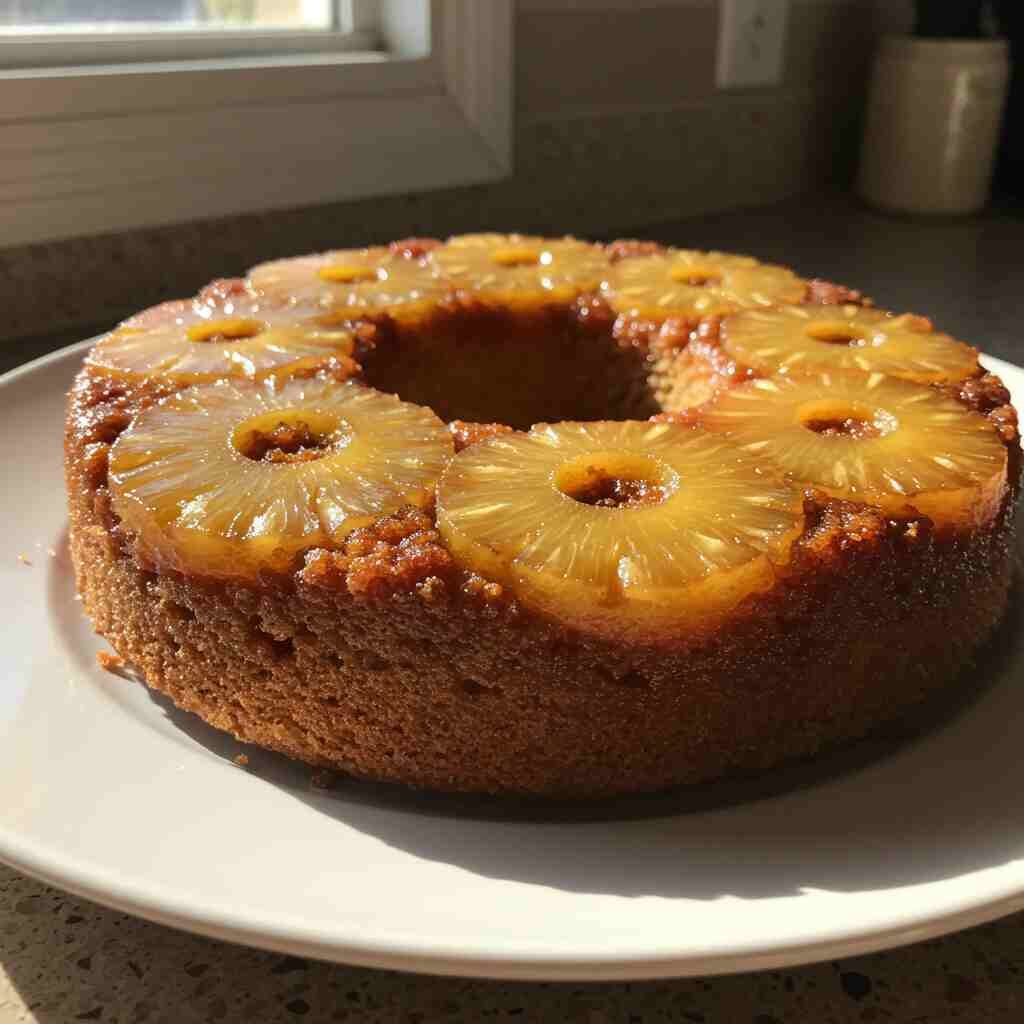
Troubleshooting Common Issues
Even experienced bakers sometimes run into challenges when making pineapple pound cake. This section helps you identify, fix, and prevent the most common problems. With these tips, you’ll create perfect pound cake every time.
Texture Problems
Too Dense Cake
A pound cake should be rich but not heavy as a brick. If your cake turns out too dense:
- Room temperature ingredients – Cold eggs and butter won’t trap enough air
- Cream butter and sugar longer – Beat for 4-5 minutes until very light
- Check your leavening – Make sure baking powder is fresh and active
- Measure flour correctly – Use the spoon and level method, not scooping
- Mix just enough – Stop as soon as ingredients combine after adding flour
The creaming step creates tiny air pockets that give pound cake its structure. Spend extra time on this step for lighter results. Beat butter alone first until smooth, then add sugar and beat until the mixture looks almost white.
Too Crumbly Cake
If your cake falls apart when you slice it:
- Add more moisture – Include an extra 2-3 tablespoons of liquid
- Check your fat ratio – Make sure you used full-fat ingredients
- Add one more egg yolk – This helps bind ingredients together
- Include 1/4 cup sour cream – Adds moisture and helps structure
- Bake for less time – Even 5 minutes too long can dry out your cake
Most crumbly pineapple cake problems come from too little moisture or too much flour. Next time, measure your flour by weight if possible (about 120g per cup).
Uneven Baking
Signs of uneven baking include dark edges with soggy middle or domed tops:
- Check your oven temperature – Use an oven thermometer for accuracy
- Rotate pan halfway through baking – Turn it 180 degrees for even heat
- Use the right pan size – Too small pans make thick cakes that bake unevenly
- Place rack in center position – This gives the best heat circulation
- Use baking strips around your pan – These help cakes rise more evenly
Many home ovens run hotter or colder than the setting shows. An oven thermometer costs just a few dollars and helps solve many baking problems.
Moisture Balance
Too Dry Solutions
A dry pound cake disappoints everyone. Fix this issue by:
- Reduce baking time – Start checking 10 minutes before recipe suggests
- Add a simple syrup soak – Brush warm cake with sugar-water syrup
- Include more fruit – Extra pineapple adds moisture throughout
- Try cake flour – It absorbs less liquid than all-purpose flour
- Add 2-3 tablespoons oil – This increases moisture without changing structure
For the syrup soak, mix equal parts sugar and water (or pineapple juice), heat until sugar dissolves, then brush over warm cake. This adds moisture and sweetness in one step.
Too Wet Fixes
If your cake seems soggy or undercooked:
- Drain pineapple thoroughly – Press out extra juice with paper towels
- Bake longer at lower temperature – Try 325°F for extra 5-10 minutes
- Let cake cool completely – The texture improves as it cools
- Add 2 extra tablespoons flour – This helps absorb excess moisture
- Use less pineapple – Try reducing amount by 1/4 cup
A cake tester or toothpick should come out clean when inserted in the center. If you see wet batter, your cake needs more time. A few moist crumbs are fine – this shows your cake stays moist.
Pineapple-Specific Concerns
Preventing Sinking Fruit
Nothing ruins a pineapple pound cake like all the fruit sinking to the bottom. Prevent this by:
- Drain pineapple extra well – Less liquid means lighter pieces
- Toss fruit with 1 tablespoon flour – This helps it grip the batter
- Use crushed pineapple – Smaller pieces distribute more evenly
- Make sure batter has proper thickness – It should fall slowly from spoon
- Fill pan in layers – Add 1/3 batter, then pineapple, repeat layers
The flour coating makes a huge difference. It creates a barrier between the moist fruit and cake batter, helping the pineapple stay suspended during baking.
Managing Excess Moisture
Pineapple contains lots of water, which affects your pound cake recipe. Control the moisture by:
- Drain canned pineapple in a strainer – Let sit 15-20 minutes
- Press with paper towels – Remove surface moisture
- Cook down fresh pineapple – Reduces water content
- Consider dried pineapple – Rehydrate in rum or juice for flavor without excess water
- Add 1-2 tablespoons cornstarch – Helps absorb extra liquid during baking
For fresh pineapple, cook chunks in a skillet over medium heat for 5-7 minutes. This removes excess liquid and concentrates flavor. Cool completely before adding to your cake batter.
Fixing a Failed Cake
Don’t throw away a less-than-perfect pineapple pound cake! Try these rescue ideas:
- Slice and toast – Toasting slices caramelizes sugars and improves texture
- Make trifle – Layer cake pieces with whipped cream and extra pineapple
- Create cake pops – Crumble cake, mix with frosting, and form into balls
- Top with ice cream – A scoop of vanilla hides many flaws
- Turn into bread pudding – Cube cake, soak in custard mixture, and rebake
Even professional bakers have off days. The mark of a good baker isn’t never making mistakes—it’s knowing how to fix them creatively.
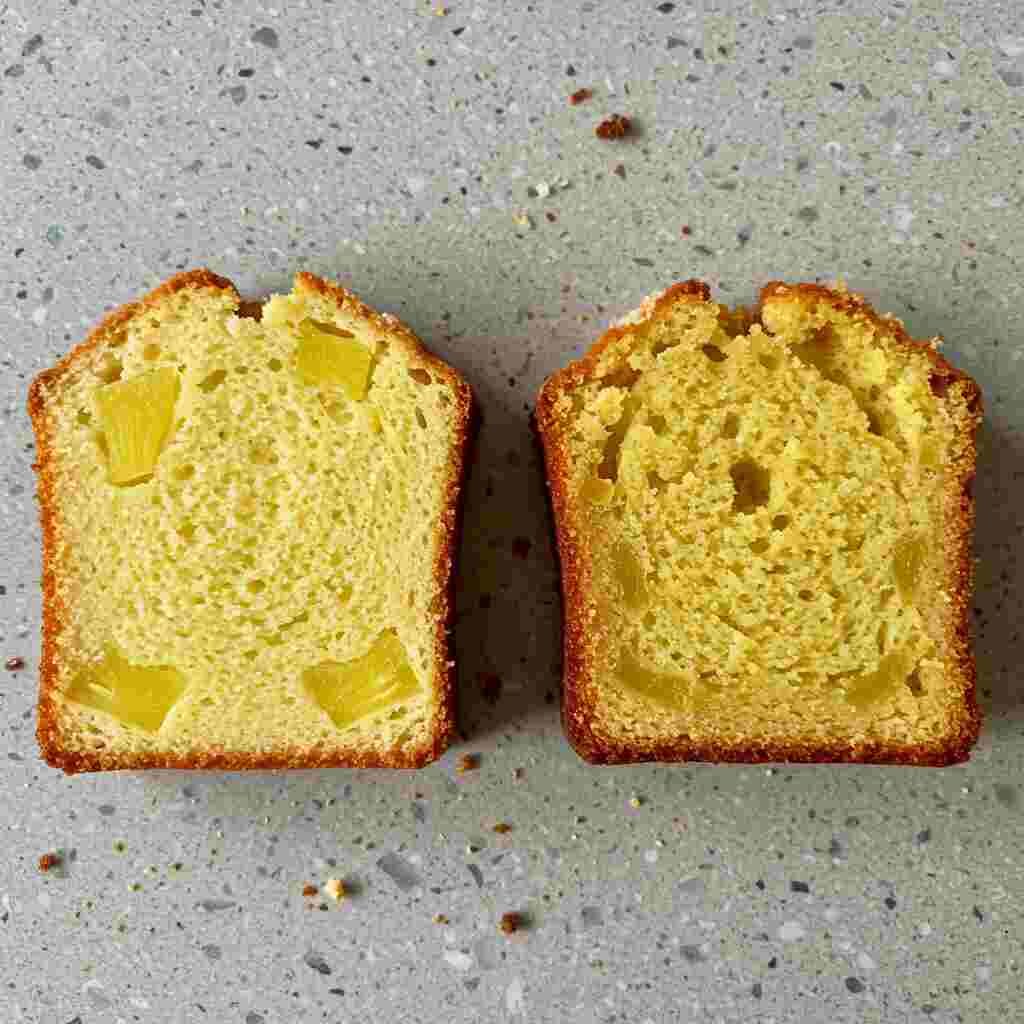
When to Start Over
Sometimes a fresh start saves time and ingredients. Consider starting over if:
- Cake sinks dramatically in the center after removal from oven
- Center remains completely raw while edges burn
- You forget a major ingredient like eggs or leavening
- Cake tastes strongly of baking soda or has bitter taste
- Texture resembles rubber or gummy bears
Most other problems have fixes or workarounds. But these major issues usually mean something fundamental went wrong in the recipe or process.
FAQs About Pineapple Pound Cake
Readers ask many common questions about making pineapple pound cake. Here we answer the most frequent ones with practical advice and helpful tips.
Can I use pineapple juice instead of water in a box cake mix?
Yes! Replacing water with pineapple juice in boxed cake mix creates delicious results. Here’s how to do it right:
Use an equal amount of juice to replace the water called for
Reduce sugar in the recipe by 1-2 tablespoons if the juice is sweetened
Add 1 extra tablespoon of flour to balance the extra sugar in juice
Consider adding 1/2 teaspoon of vanilla to enhance the flavor
Mix the batter for an extra 30 seconds to incorporate the juice well
This simple swap adds natural pineapple flavor throughout your cake. The acid in pineapple juice also helps create a more tender crumb. For even more flavor, add 1/2 cup of well-drained crushed pineapple to the batter.
What is the difference between a pound cake and a regular cake?
Pound cake differs from regular cake in several key ways:
Ingredients ratio – Traditional pound cake uses equal weights of flour, butter, sugar, and eggs
Texture – Pound cake has a more dense, tight crumb while regular cake is lighter and fluffier
Leavening – Pound cake relies mainly on creamed butter and eggs for rise rather than large amounts of baking powder
Moisture – Pound cake contains more fat, making it more moist and rich
Shelf life – Pound cake stays fresh longer than regular cake due to higher fat content
The name “pound cake” comes from the original recipe that used one pound each of butter, sugar, eggs, and flour. Modern recipes often change these proportions but keep the rich, dense character of the original.
Why is it called upside down pineapple cake?
The name upside-down pineapple cake describes exactly how this cake works:
Fruit and sugar mixture goes in the bottom of the pan
Cake batter goes on top of the fruit
During baking, the fruit caramelizes in the sugar and butter
After baking, you flip the cake over (upside down)
The fruit layer becomes the decorative top of the cake
This method dates back to the early 1900s when cooking in cast iron skillets was common. Homemakers would place fruit and sugar in the skillet bottom, pour batter on top, and cook over fire or in ovens. Flipping the cake revealed the beautiful fruit pattern on top.
Why is it called Elvis Presley pound cake?
The Elvis Presley pound cake got its name because it was one of the singer’s favorite desserts. According to stories from his personal cook:
Elvis loved a very rich, buttery pound cake
His personal recipe used 7 eggs and 2 sticks of butter
The cake featured a thick vanilla glaze
His version contained no fruit but had extra vanilla
The recipe became famous after appearing in his mom’s cookbook
While the original Elvis pound cake didn’t include pineapple, many variations now add it because Elvis also loved Hawaiian flavors. A pineapple pound cake with banana makes an “Elvis-inspired” version that nods to his famous peanut butter and banana sandwiches
What makes a cake more moist: water or milk?
Milk makes a moister cake than water because:
Milk contains fat that adds richness and moisture
The protein in milk creates a more tender texture
Milk adds flavor that water doesn’t provide
Lactose (milk sugar) helps with browning and flavor
Milk’s pH affects how the cake rises and sets
For the moistest results in your pineapple pound cake, consider these options:
Whole milk provides more moisture than skim milk
Buttermilk adds tanginess and makes an extra tender crumb
Half-and-half or even heavy cream creates an ultra-rich result
Coconut milk pairs perfectly with pineapple for tropical flavor
Evaporated milk concentrates the milk proteins and sugar for unique flavor
The fat content makes the biggest difference in moisture level. If you must use water, add an extra tablespoon of butter or oil to the recipe.
Can I add crushed pineapple to cake mix?
Absolutely! Adding crushed pineapple to cake mix creates delicious results with a few simple steps:
Drain one 8-ounce can of crushed pineapple very well
Save the juice to replace part of the water in the mix
Fold the crushed pineapple in as the last step of mixing
Extend baking time by 5-7 minutes to account for extra moisture
Use a toothpick to check for doneness in the center
For a box mix, the standard size (15.25 oz) works best with one 8-ounce can of crushed pineapple. If you use larger cans, the cake might become too wet and dense. Press the drained pineapple with paper towels to remove excess moisture for best results.
Health and Dietary Considerations
While pineapple pound cake makes a delightful treat, many people have dietary needs or preferences to consider. Here’s how to enjoy this dessert with various health considerations in mind.
Nutritional Information
A typical slice of pineapple pound cake (about 1/12 of a standard recipe) contains:
- Calories: 320-350 per slice
- Fat: 14-18 grams (mostly from butter)
- Carbohydrates: 45-50 grams
- Sugar: 30-35 grams
- Protein: 4-5 grams
- Fiber: 1-2 grams (thanks to the pineapple)
The pineapple adds vitamins and minerals not found in plain pound cake, including vitamin C, manganese, and bromelain (an enzyme with anti-inflammatory properties).
Dietary Adaptations
Gluten-Free Version
You can make gluten-free pineapple pound cake with these substitutions:
- Use a quality gluten-free flour blend with xanthan gum
- Add an extra egg to help with binding
- Include 1/4 cup sour cream or Greek yogurt for moisture
- Beat the batter an extra minute to develop structure
- Cool completely in the pan before removing
Gluten-free flours absorb moisture differently than wheat flour. You might need to adjust the liquid slightly. Start with the recipe as written, then add 1-2 tablespoons of milk if the batter seems too thick.
Dairy-Free Alternatives
For dairy-free pound cake, substitute:
- Vegan butter sticks for regular butter (same amount)
- Coconut cream for milk or cream (same amount)
- Vegan cream cheese for cream cheese frosting
- Coconut oil (solid state) for part of the butter
- Extra vanilla to boost flavor without dairy
Dairy-free versions work best with extra flavor from the pineapple and vanilla since they lack the richness of butter. The coconut and pineapple flavors complement each other beautifully.
Sugar Substitutions
Reduce sugar or use alternatives:
- Use 2/3 the amount of sugar called for in the recipe
- Try a 50/50 blend of sugar and monk fruit sweetener
- Substitute coconut sugar for a lower glycemic option
- Use stevia baking blend according to package directions
- Add extra vanilla and cinnamon to boost sweetness perception
Remember that sugar affects texture and browning, not just sweetness. Using less sugar creates a less tender cake. Sugar substitutes work best in recipes with fruit like pineapple, which adds natural sweetness.
Conclusion
Pineapple pound cake brings together the best of two worlds—the rich, buttery goodness of traditional pound cake and the sweet-tart tropical flavor of pineapple. This versatile dessert works for casual family gatherings and special occasions alike.
The key to success lies in understanding the role of each ingredient and following the proper techniques. Take your time with the creaming process, measure ingredients accurately, and monitor your baking time carefully.
Don’t be afraid to experiment with the variations we discussed. Whether you prefer a simple pineapple-studded pound cake, an impressive upside-down version, or a coconut-pineapple flavor explosion, this basic recipe provides a fantastic starting point.
With the troubleshooting tips in this guide, you can overcome common baking challenges and create perfect results every time. Remember that even imperfect cakes usually taste delicious, so enjoy the process and the results.
Happy baking, and enjoy your delicious pineapple pound cake creation!
Irresistible Pineapple Pound Cake: A Tropical Treat You’ll Love
If you’re looking for a moist, flavorful dessert that brings a taste of the tropics to your table, the pineapple pound cake is a must-try. Known for its rich, buttery crumb and bursts of juicy pineapple, this cake is perfect for everything from summer parties to holiday gatherings.
This classic Southern-style dessert blends sweet crushed pineapple with a dense, buttery base that’s incredibly satisfying. Whether you prefer it plain, glazed, or with a tropical twist like toasted coconut or rum drizzle, pineapple pound cake is as versatile as it is delicious.
Looking for creative ways to decorate or serve your pineapple pound cake? Check out this Pinterest board full of pineapple pound cake ideas to inspire your next baking adventure. From mini bundts to upside-down versions, there’s no limit to the beautiful and tasty variations you can try.
Don’t forget to explore our full recipe and expert tips right here on ToDaRecipes — because a great cake starts with the perfect recipe.


